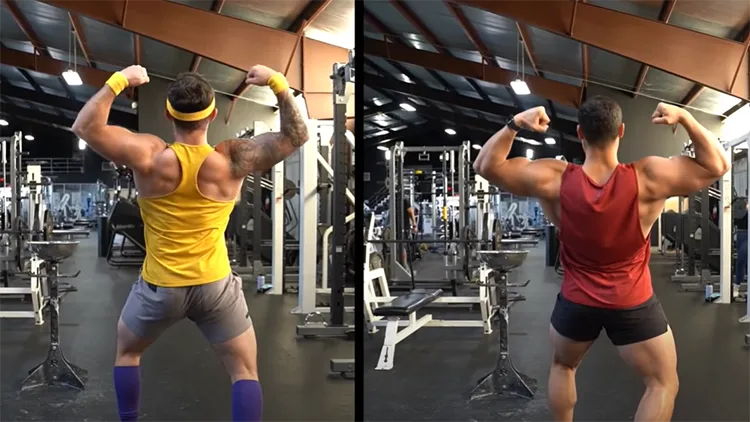
Bad bicep genetics plague gym goers worldwide, but what exactly do crummy bicep genetics look like, to determine if you have subpar bicep genetics, you can test your muscle growth response to various exercises. If the results are not satisfactory, the best approach to achieve larger biceps and overcome genetic limitations is to adopt a tailored exercise regimen and possibly consult a fitness expert for personalized advice.1
This article will discuss a variety of topics such as genetic factors like bicep insertions, bicep peaks, asymmetries, what “excellent bicep genetics” even means and the typical bicep size of men and women to see how you compare.
Excellent vs Poor Bicep Genetics: What’s the Difference?
When it comes to bicep genetics, there are a few key things that separate the good from the bad. First and foremost, the size of a person’s biceps will play a big role in how successful they are in developing them.
Those with smaller biceps will have a harder time adding mass, while those with larger biceps will be able to build them up relatively easily.
Another factor that comes into play is the shape of the biceps.
Those with rounder, fuller biceps will have an easier time adding mass than those with flatter, thinner biceps. This is because the muscles in a person’s biceps can contract more efficiently when they are fuller and rounder.
Finally, the location of one’s biceps will also affect how easy it is to build them up.
Those with biceps that are closer to the elbow will have an easier time adding mass than those with biceps that are further away from the elbow because there is a larger muscle belly to grow.
So, to understand whether a person has good or poor bicep genetics, it’s important to consider all of these factors. Those with excellent bicep genetics will typically have larger, fuller, and rounder biceps that are located close to the elbow.
This gives them a major advantage when it comes to building up their biceps.
What Does Poor Bicep Genetics Look Like?
Poor bicep genetics typically result in smaller, flatter, and thinner biceps that are located further away from the elbow. Combined with being less aesthetically pleasing, a short bicep may limit the ability to grow muscle when compared to someone with good genetics.
Of course, having poor bicep genetics is very different from having bad shoulder genetics since biceps are highly sought after whereas shoulders aren’t fixated by gym bros nearly as much.
But don’t worry, because it’s important to remember that they can still build up their biceps with hard work and patience, just like any other muscle.
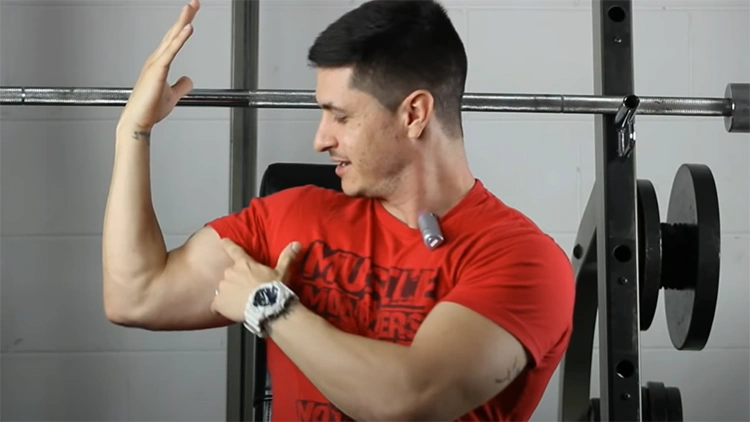
In our opinion, this guy doesn’t have poor bicep genetics or excellent bicep genetics since his insertion point is neither high or low. Source: musclemonsters on Youtube2
In fact, even short-term training of the biceps brachii muscle led to a 28% increase in the 1 rep max in the arm in one study, even without muscle growth.3 This means that getting stronger but not bigger can happen, and that isn’t necessarily a bad thing since strength and size are highly correlated.
However, it will likely take longer to see results and it may be difficult to achieve the same level of muscle growth as someone with excellent bicep genetics.
A High Bicep Insertion is Considered Bad Bicep Genetics (Poor Bicep Insertions)
A high bicep insertion is when the biceps muscle attaches higher up on the arm, closer to the shoulder. This is considered bad bicep genetics because it makes it harder for the biceps to contract efficiently. Additionally, poor bicep insertions typically result in smaller, less full biceps that are located further away from the elbow.
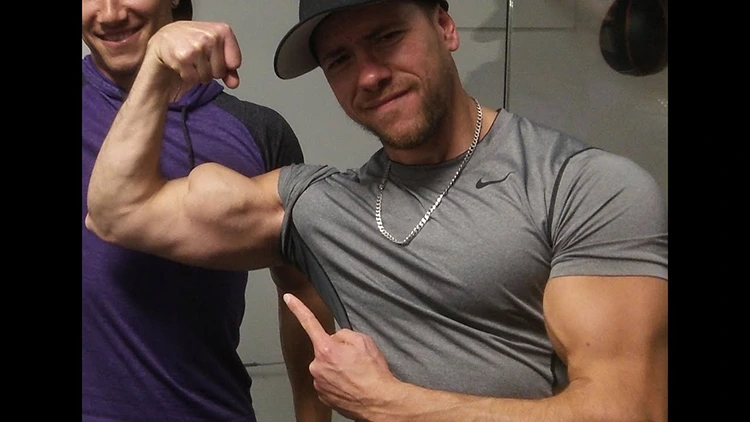
Take note of where his bicep ends and the vast distance from his elbow. Source: luimarco on Youtube4
In the picture above, it is easy to see that there is a large gap between the elbow and the end of the bicep; this is a perfect example of what someone would call poor bicep genetics.
No or Uneven Bicep Peak
No bicep peak is when the biceps muscle does not have a defined “peak” or “bump.” This may appear as a very flat, linear bicep without curves, or even have a peak that is off center.
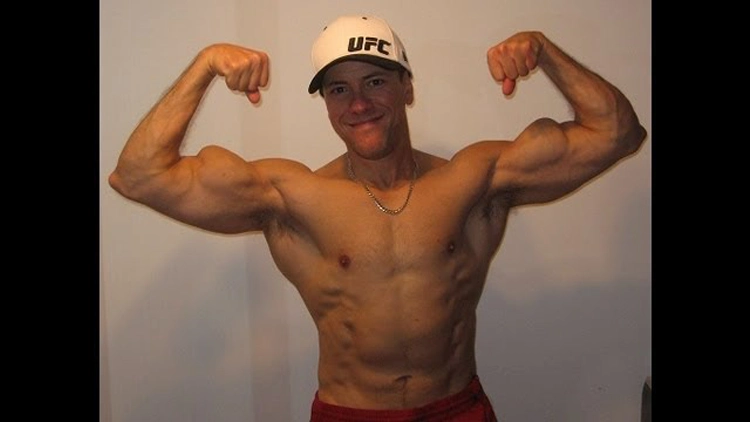
Check out how the left bicep peak (his right arm) is much more sharp and defined than the right (his left arm). Source: luimarco on Youtube5
Take this picture for example. While he has well-defined biceps, the peak is clearly not in the center of the bicep, lending to a less aesthetically pleasing look as compared to someone who has a centered bicep peak (which looks more symmetrical).
How To Test If You Have High Bicep Insertions
You can determine if you have high bicep attachments by using a few different methods.
The first way is to flex the biceps and see how high up on the arm the muscle attaches. If it attaches higher up, closer to the shoulder, then that individual likely has high bicep insertions.
This can also more rigidly be tested by applying the bicep finger test. To do the bicep finger test, bend at the elbow at a 90-degree angle and flex the bicep. When the bicep is flexed, insert as many fingers as possible between the end of the bicep and the forearm.
This gap between the muscle belly is a trivial, but useful way of determining if a person has high bicep insertions.
If a person can fit more than one finger in the gap between the bicep muscle belly and their forearm, they are considered to have a high bicep insertion. Someone who can only fit one finger, or even less than one finger, they are considered to have a low bicep attachment, which some see as better.
What Do Excellent Bicep Genetics Look Like?
There are a few things that excellent bicep genetics look like. The first is a low bicep attachment, which means the biceps muscle attaches lower down on the arm, closer to the elbow. This is considered excellent bicep genetics because it makes it easier for the muscles in your biceps to contract efficiently.
Additionally, a low bicep attachment typically results in bigger, rounder, and fuller biceps that are located closer to the elbow.
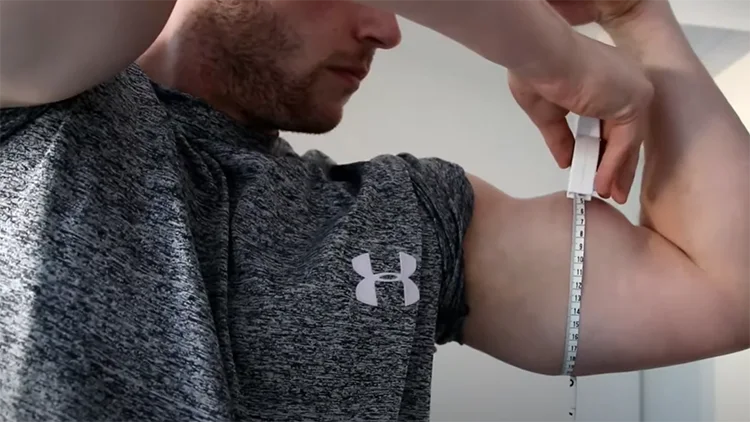
Source: Jacob McDonald on Youtube6
excellent bicep genetics also typically include a well-defined bicep peak. This is when the biceps muscle has a clear peak Additionally, a well-defined bicep peak typically results in bigger, rounder, and fuller biceps that are located closer to the elbow.
A Low Bicep Attachment is Considered Excellent Bicep Genetics
A low bicep attachment is when the biceps muscle attaches lower down on the arm, closer to the elbow.

Note how his bicep insertion point is so low, it’s near his elbow. Source: mustafagull via Canva.com7
This is considered excellent bicep genetics because it makes it easier for the muscles in the biceps to contract efficiently, and combined with the fact that it attaches closer to the elbow, it has an overall fuller look.
A High Bicep Peak
A well-defined bicep peak is considered excellent bicep genetics for a few reasons.
Most people who are concerned about their bicep and arm genetics in general, aesthetically want to have fuller, larger-looking arms. It should be quite obvious that a higher bicep peak, one that has a more well-rounded, ‘peakier’ look, is better than one that has an uneven peak.
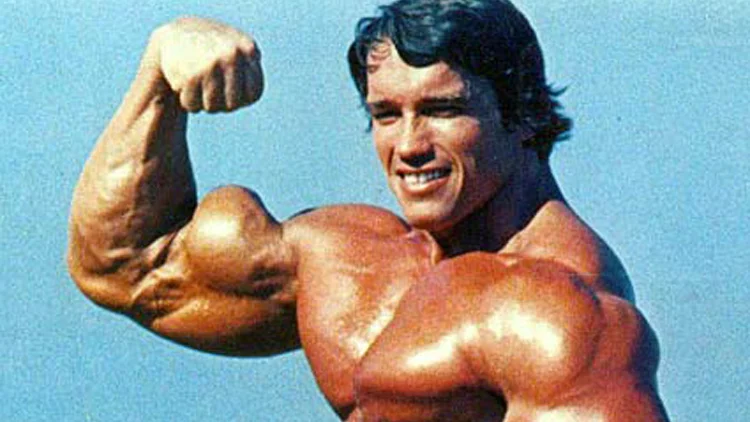
The legend Arnold Schwarzenegger has a very pronounced bicep peak which makes his physique look that much more impressive. Source: u/Fuh_Queue on Reddit8
As seen above, Arnold Schwarzenegger, one of the top 10 bodybuilders of all time, was blessed with astounding bicep genetics, with a round, high peak, and a low bicep attachment.
What Is the Typical Bicep Size? What’s the Typical Bicep Size by Height?
Luckily, the Centers for Disease Control and Prevention (CDC) collected, compiled, and analyzed data from 2011-2014 on children and adults to gather the information that helps to answer these questions.9
To get the below numbers, the midarm circumference for various people was determined by measuring the biceps at their peak.
Considering there were over 11000 participants in this part of the study, it is likely that it was conducted on a non-flexed bicep since the vast majority of the population doesn’t work out.
With all of that in mind, to begin, the typical bicep size by gender should be looked at.
The Typical Bicep Size of Men
The typical bicep size of an American man over 20 years old is 13.5 inches, which, ultimately, is not that large for anyone who’s been lifting for more than a few months.
On the other hand, some professional bodybuilders can have biceps up to 25 to 30 inches large, with most competitors being in the 20 to 24-inch range.
That being said, take a look at some data on how different aged men’s biceps compare:
- 20 years and over: 13.5 inches
- 20-29 years old: 13.27 inches
- 30-39 years old: 13.78 inches
- 40-49 years old: 13.9 inches
- 50-59 years old: 13.54 inches
- 60-69 years old: 13.39 inches
- 70-79 years old: 12.91 inches
- 80-89 years old: 12.16 inches
The Typical Bicep Size of Women
Interestingly enough, the typical bicep size of women is not that much smaller than men. The typical bicep size of women over 20 is just under 13 inches, with the size not fluctuating much over an entire woman’s lifespan.
- 20 years and over: 12.68 inches
- 20-29 years old: 12.36 inches
- 30-39 years old: 12.87 inches
- 40-49 years old: 12.87 inches
- 50-59 years old: 12.91 inches
- 60-69 years old: 12.76 inches
- 70-79 years old: 12.64 inches
- 80 years and over: 11.46 inches
Between the ages of 20 and 70, there is not much fluctuation in bicep size, but for women over the age of 80, there is quite a bit of drop-off in bicep size. It seems like the bicep size of women changes in a similar way to how men’s bicep sizes change as they age.
The Typical Bicep Size By Height
“What is the typical bicep size by height” is an extremely common question in people who are researching their biceps. Unfortunately, the answer to this question is not very satisfying: no one knows.
There has not been research conducted on what the typical bicep size by height is, other than anecdotal ‘evidence’ from lifters on bro-science forums.
The statement suggests that while it’s generally believed that someone with a larger skeletal mass can develop more muscle, it’s uncertain how this influences muscle growth in specific body areas.
This raises the issue of what other factors influence the maximum bicep peak, including how the location of the bicep insertion affects typical bicep size and the impact of poor and excellent bicep genetics on the size of the peak.
With so many factors that exist in terms of changing bicep size, it is extremely difficult to create a study that controls all of them to conclude definitive evidence on the typical bicep size by height. In more simplified terms, it is very difficult to calculate the typical bicep size solely based on height, so it has not been done quite yet.
However, there is evidence that shows there is a benefit to doing more volume for the bicep rather than less. A 2019 study conducted on 49 experienced resistance-trained men showed that 14 sets of biceps training per week were statistically more effective for building 1RM strength and size.10
It should also be said that training the biceps specifically with movements like the bicep curl will be significantly more effective for growth than movements which only target the bicep partially, like deadlifts.
High Bicep Attachments vs Low Bicep Attachments: Which is Poor Arm Genetics? Which is More Aesthetic?
When it comes to the biceps, there are two types of insertions: high and low. A high insertion is when the biceps start higher up on the humerus, and a low insertion is when the biceps start lower down on the humerus.
The vast majority of people have low bicep attachments, while a small percentage have high bicep insertions. It is debatable which type is more aesthetic, and determining if someone has high bicep attachments can be unclear.
The answer to the first question is subjective; some people prefer the look of high bicep insertions, while others prefer low bicep attachments.
As for the second question, most people believe that low bicep attachments provide better leverage for lifting heavy weights; however, there is no scientific evidence to support this claim.
In terms of aesthetics, it is ultimately up to the individual; some people prefer the look of high bicep insertions, while others prefer low bicep attachments. There is no right or wrong answer, and it is ultimately a matter of preference.
What Makes For Poor Tricep Genetics?
For the sake of being comprehensive, there are a few different factors that can contribute to poor tricep genetics but many of the same concepts of bag bicep genetics still apply.
One of the most common is having a short tricep, one where the muscle is inserted higher up on the arm. This can make it difficult to develop the triceps, as the muscle will not be able to contract as efficiently.

Source: Unbiased Ankur on Youtube11
Another factor that can contribute to poor tricep genetics is having a wide humerus. This can again make it difficult to develop the triceps, as the muscle will not be able to contract as efficiently.
Finally, having poor leverage or short forearms can also contribute to poor tricep genetics. This means that the triceps will have to work harder to move the weight, which can make it difficult to develop.
Overall, doing movements such as the bench press can contribute to the overall strength of the tricep, but targeted movements like narrow grip bench press or tricep pushdown will be best for targeting the triceps.
How To Overcome Bad Bicep Genetics & Poor Muscle Genetics
The first step to overcoming poor bicep genetics or bad bodybuilding genetics is to accept that one has them. This may sound like a simple task, but it is actually quite difficult for many people.
This is because a person who is irritated with the fact that they have poor bicep genetics may be prone to thinking training them is worthless – this is simply not the case.
One of the best ways to overcome poor bicep genetics is to focus on compound exercises like the chin-ups and pull ups. These exercises will work multiple muscles at the same time, which can help to offset the poor bicep genetics while also putting more stress on them than bicep isolation exercises do.
After you’ve done all compound exercises for a session, then move on to bicep isolation exercises such as hammer curls, preacher curls, spider curls etc.
Be sure to utilize a variety of different bicep exercises and grips from pronated (overhand), supinated, and even neutral. Point being, reverse curls muscles worked differ slightly than underhand curls.
Beginner hypertrophy programs frequently include movements like these to emphasize arm growth.
Another way to overcome poor bicep genetics is to focus on high-intensity training with super sets, drop sets, giant sets etc. This type of training will force the muscles to work harder and closer to failure, which can help to overcome poor bicep genetics.
Finally, another way to overcome poor bicep genetics is to focus on getting adequate volume while training and getting enough sets, reps and weight to progressively overload your biceps.
No joke, if you aren’t getting in enough volume — and “enough volume” differs from person to person — then you will not see much or any progress. See what Dr. Mike has to say in the video below to figure out how much volume is enough for YOUR biceps.
There are a wide variety of reasons why a person may not be happy with the genetics they were born with, regardless of if they are bad chest genetics or bad ab genetics.
But, especially for those with bad bicep genetics, training properly and understanding what an individual’s genetics are can be the difference between okay biceps, and biceps that turn heads.
References
1“Do You Have “Good” or “Bad” Muscle-Building Genetics? (5 SIGNS).” YouTube, 25 April 2021. Accessed 6 April 2023. <https://www.youtube.com/watch?v=SD-yAFfLCXg&t>
2“Do You Have Good or Bad Muscle-Building Genetics?” YouTube, 5 March 2015. Accessed 5 April 2023. <https://www.youtube.com/watch?v=lK6crDZV35M>
3Kidgell, D., Stokes, M., Castricum, T., & Pearce, A. (2010). Neurophysiological responses after short-term strength training of the biceps brachii muscle. Journal of Strength and Conditioning, 24(11), 3123-32. <https://pubmed.ncbi.nlm.nih.gov/20881507/>
4“The Biceps Peak, Genetic Or Not ?” YouTube, 24 November 2012. Accessed 5 April 2023. <https://www.youtube.com/watch?v=eOegIx5TeUY>
5“The BEST Biceps Exercise Ever.” YouTube, 13 February 2011. Accessed 5 April 2023. <https://www.youtube.com/watch?v=b88TXnwSZWQ>
6“HOW BIG ARE MY ARMS AND LEGS? (BICEPS, FOREARMS …” YouTube, 19 May 2017. Accessed 5 April 2023. <https://www.youtube.com/watch?v=wfdzy_BEHmM>
7mustafagull. “Flexing Muscles.” Canva. Accessed 6 April 2023. <https://www.canva.com/photos/MAEENOqfNlU-flexing-muscles/>
8“Some pictures of Arnold I had never seen before. His biceps peak in the first one is ridiculous. : r/bodybuilding.” Reddit. Accessed 6 April 2023. <https://www.reddit.com/r/bodybuilding/comments/vzsig/some_pictures_of_arnold_i_had_never_seen_before/>
9Fryar, C. D., Gu, Q., & Ogden, C. L. (2016). Vital and Health Statistics, Series 3, Number 39, (08/2016). CDC. Retrieved November 18, 2022, from <https://www.cdc.gov/nchs/data/series/sr_03/sr03_039.pdf>
10Heaselgrave, S., Blacker, J., Smeuninx, B., McKendry, J., & Breen, L. (2019). Dose-Response Relationship of Weekly Resistance-Training Volume and Frequency on Muscular Adaptations in Trained Men. International Journal of Sports Physiological Performance, 14(3), 360-368. <https://pubmed.ncbi.nlm.nih.gov/30160627/>
11“Build Big Triceps Even With Bad Genetics NATURALLY.” YouTube, 30 May 2019. Accessed 6 April 2023. <https://www.youtube.com/watch?v=3szurApyp08&t>